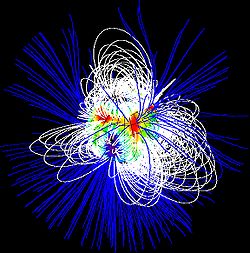| Observation data Epoch J2000 Equinox J2000 | |
|---|---|
| Constellation | Auriga |
| Right ascension | 04h 55m 59.38527s[1] |
| Declination | +30° 34′ 01.5190″[1] |
| Apparent magnitude (V) | 9.30[2] |
| Characteristics | |
| Spectral type | G2IIIne[2] |
| B−V color index | +0.74[3] |
| Variable type | T Tauri |
| Astrometry | |
| Radial velocity (Rv) | 23.20[4] km/s |
| Proper motion (μ) | RA: 1.18[1] mas/yr Dec.: -22.24[1] mas/yr |
| Parallax (π) | 6.85 ± 2.23 mas[1] |
| Distance | approx. 500 ly (approx. 150 pc) |
| Absolute magnitude (MV) | +2.83[3] |
| Details[3] | |
| Mass | 2.0±0.1 M☉ |
| Radius | 2.61+0.20 −0.23 R☉ |
| Luminosity | 6.3±1.6 L☉ |
| Surface gravity (log g) | 3.91+0.07 −0.10 cgs |
| Temperature | 5550±100 K |
| Rotation | 1.76+0.29 −0.33 |
| Rotational velocity (v sin i) | 66.2 km/s |
| Age | 4 Myr |
| Other designations | |
| Database references | |
| SIMBAD | data |
SU Aurigae is a T Tauri-type variable star in the constellation Auriga. It is located about 500 light-years (150 parsecs) away in the Taurus-Auriga Star Forming Region. Its apparent magnitude is 9.30, which is dim enough that it cannot be seen with the unaided eye.
SU Aurigae's spectral type of G2IIIne means that it is a G-type star with an effective temperature similar to the Sun. The III in the spectral type refers to its luminosity, which is much higher than normal G-type main sequence stars and would put it in the giant star class.[5] However, it is only about 4 million years old, which is relatively young for a star - young protostars like SU Aurigae are luminous because they are larger, not condensing into a normal size until they are older.[6]

SU Aurigae is known to have a circumstellar protoplanetary disk surrounding it, which is typical of many T Tauri stars.[6] SU Aurigae's disk has a high inclination of 62° and is nearly perpendicular to the plane of sky, so orbiting protoplanets or comets may be the cause of why there are drops in the amount of light detected.[3] SU Aurigae's proper motion and distance is similar to AB Aurigae,[1] a better known pre-main-sequence star, meaning that the two may form a very wide binary system;[5] if not, they are still in the same star association.
- ^ a b c d e f van Leeuwen, F. (2007). "Validation of the new Hipparcos reduction". Astronomy and Astrophysics. 474 (2): 653–664. arXiv:0708.1752. Bibcode:2007A&A...474..653V. doi:10.1051/0004-6361:20078357. S2CID 18759600.
- ^ a b "SU Aur". SIMBAD. Centre de données astronomiques de Strasbourg. Retrieved 17 January 2016.
- ^ a b c d DeWarf, L. E.; Sepinsky, J. F.; Guinan, E. F.; Ribas, I.; Nadalin, I. (2003). "Intrinsic Properties of the Young Stellar Object SU Aurigae". The Astrophysical Journal. 590 (1): 357–367. Bibcode:2003ApJ...590..357D. CiteSeerX 10.1.1.508.2455. doi:10.1086/374979. S2CID 122600915.
- ^ Gontcharov, G. A. (2006). "Pulkovo Compilation of Radial Velocities for 35 495 Hipparcos stars in a common system". Astronomy Letters. 32 (11): 759–771. arXiv:1606.08053. Bibcode:2006AstL...32..759G. doi:10.1134/S1063773706110065. S2CID 119231169.
- ^ a b "AB Aurigae - Jim Kaler". 4 January 2013. Retrieved 17 January 2017.
- ^ a b "Encyclopedia of Science: T Tauri star". Archived from the original on 27 January 2021. Retrieved 17 January 2017.
- ^ Cite error: The named reference
Grankinwas invoked but never defined (see the help page). - ^ Cite error: The named reference
Codywas invoked but never defined (see the help page).
